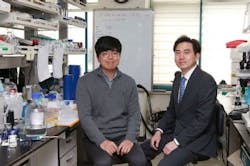Photodynamic therapy approach could treat cancer with fewer side effects
A team of researchers at the Korea Advanced Institute of Science and Technology (KAIST; Daejeon, Korea) has developed a near-infrared (near-IR) photodynamic therapy (PDT; a way to cure wounds with lasers instead of drug treatment) method that reduces the downsides of existing PDT.
Related: Near-IR photodynamic therapy approach effectively targets prostate cancer
In PDT, when a laser irradiates a targeted site, a photosensitizer (PS) absorbs light energy and then converts oxygen to singlet oxygen or free radicals, leading to programmed cell death. This treatment has been used widely in clinical fields, especially for skin disease because it allows noninvasive treatment. However, existing PDT methods have limitations for first-line therapy because PDT agents can cause genetic variations when they have low efficiency, therefore reducing treatment effects. The key to enhancing PDT efficiency is how much PS can be concentrated to a wanted site, which laser wavelength the PS reacts to, and how fast the PS clears organelle after treatment.
Professor Yeu-Chun Kim and his team from the Department of Chemical and Biomolecular Engineering, in collaboration with Professor Ji-Ho Park from the Department of Bio and Brain Engineering, developed a PS called mitochondria targeting photodynamic therapeutic agent (MitDt) to maximize PDT effects while reducing unwanted side effects. Mitochondria has emerged as target sites to maximize the effects of PS since they play essential roles in metabolism and have high transmembrane potential.
According to the team, when mitochondria is photodamaged by reactive oxygen species (ROS) generated after laser irradiation, they immediately lose their mitochondrial membrane potential and initiate apoptosis. Therefore, combining the PDT agent with the mitochondrial targeting agent can result in rapid damage to cancer cells, improving therapeutic efficacy and reducing unwanted side effects. To apply mitochondria-targeting PS, the team developed near-IR region PDT agents, which can be used to treat deep-tissue level cancer because of the permeability of the near-IR laser. Light scattering is also decreased, thus obtaining higher therapeutic efficacy.
However, there is a problem of generating singlet oxygen when irradiating with an near-IR laser. To address this issue, the team developed a novel PS that combines a functionalized near-IR dye and a mitochondria-targeting agent to gain the benefit of rapid organelle clearance after treatment and also remain in cancer mitochondria for a long time, amplifying the amount of ROS to the target sites irradiated by the laser. To verify the efficacy, the team injected MitDt into tumor-bearing mice. They were irradiated with an near-IR laser at 662 nm to induce cancer treatment and their cancer size was reduced up to threefold.
"This enhanced photodynamic cancer treatment has the advantage of treating a wanted site without any side effects because this PS stays longer in a mitochondrial cancer cell. We also confirmed that the PS did not cause cytotoxicity," says PhD candidate Ilkoo Noh, who led the work.
Full details of the work appear in the journal Advanced Science.
